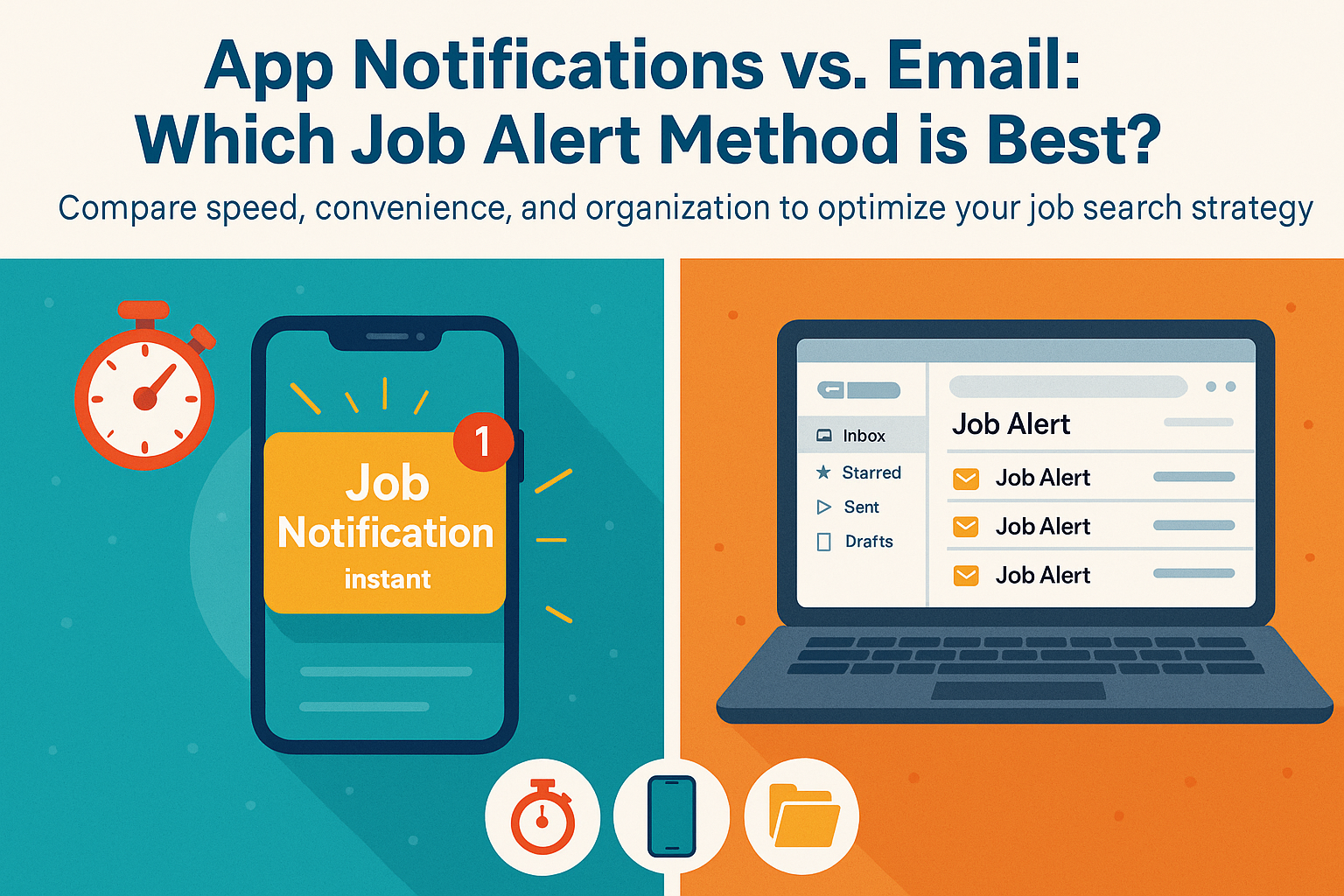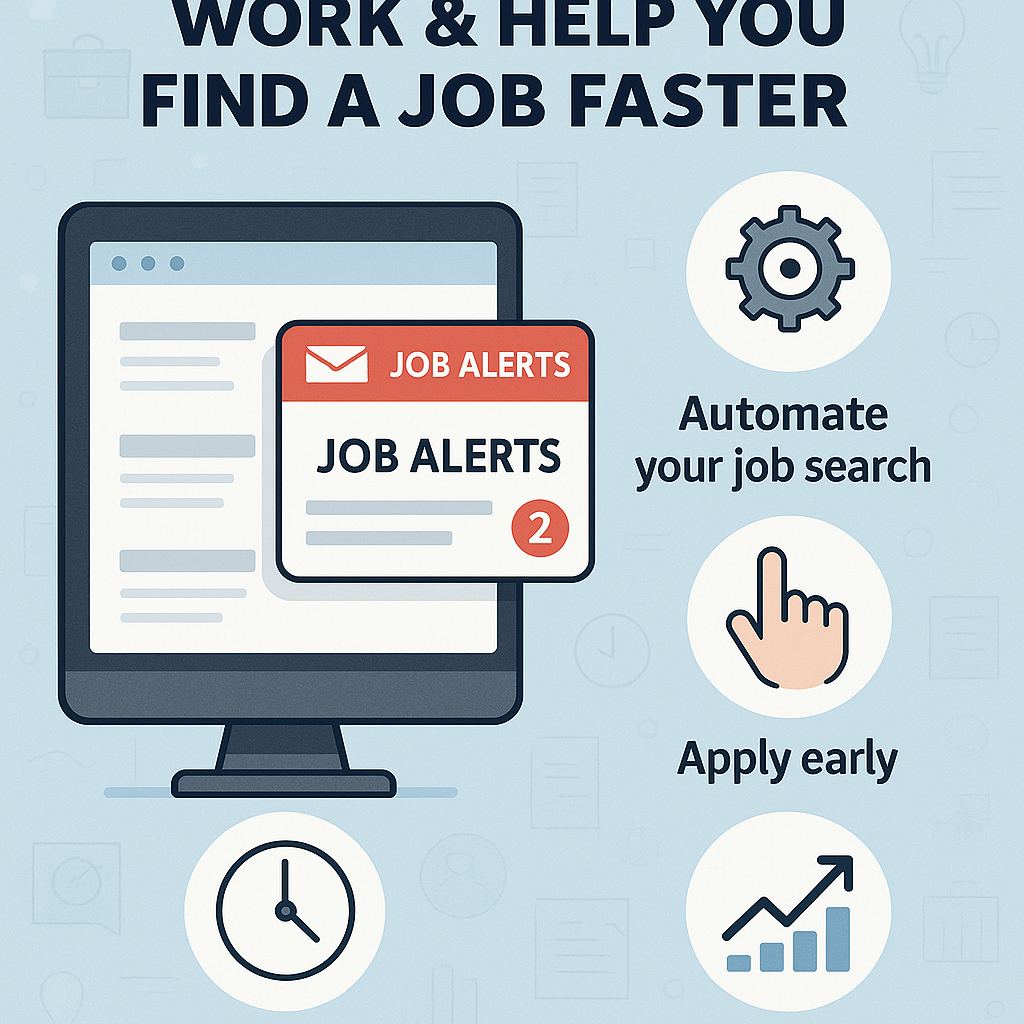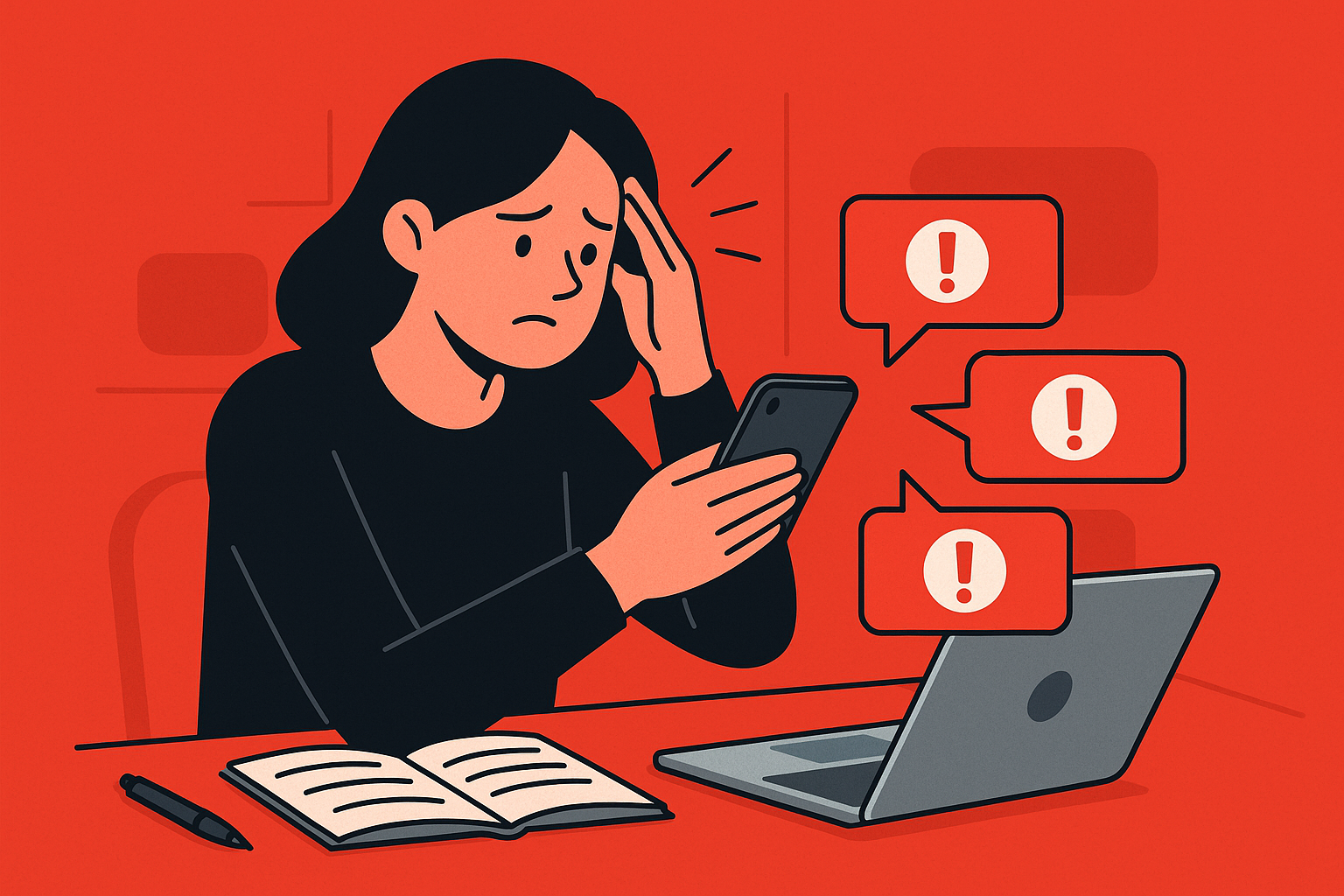Email vs App Notifications: Which Job Alert Method Works Best?

Should you use app or email job alerts? Compare both methods for speed, convenience, and organization to build the...

Learn how job alerts work to automate your job search. Discover why using them helps you apply early, save time, and...

Learn how to use job alerts effectively to apply early, personalize your applications, and stand out in a...

Should you use email or app alerts for job updates? Compare both methods and choose the best one for your job search...

Learn the biggest mistakes job seekers make with job alerts and how to fix them for better job matches, faster...

Learn how to create targeted job alerts using the right filters so you can find better roles faster, without wasting...

Learn how job alerts work, why they save time, and how to set them up to get the right job notifications directly in...
Resources
-

Set up personalized job alerts to receive notifications about new job openings that match your...
-

Find part-time job opportunities perfect for students, parents, and professionals seeking...
-

Work from home jobs across industries with flexible hours, competitive pay, and real career...
-

Create professional resumes with easy-to-use resume builders. Choose from templates, get...
-

Kickstart your career with internships tailored for students and graduates — explore paid,...
-

Remote jobs have revolutionized how we work, giving professionals the freedom to contribute from...
-

Find the best fresher jobs and entry-level opportunities across IT, Finance, Marketing, and...

If you are actively looking for a job, you already know that speed is a critical advantage. The window of opportunity for a new role can open and close quickly.
The difference between getting your application seen and getting lost in the pile often comes down to timing. This is precisely why job alerts were created: to give you a crucial head start.
However, a key question can change the effectiveness of your search: What is the best way to receive these alerts? Should you rely on traditional email, or are instant app notifications the better choice?
It's a frustratingly common experience. You find the perfect job opening, only to see it was posted five days ago, with hundreds of people already ahead of you.
Perhaps an alert for your dream job arrived, but was automatically filtered into a promotional tab in your inbox. It gets buried under retail discounts and newsletters.
If these scenarios sound familiar, your alert strategy needs an upgrade. This guide will help you move beyond these common frustrations and build a system that truly works for you.
Why a Strong Job Alert Strategy Matters More Than Ever
The modern job market is a race. Positions are filled at an unprecedented pace, with hiring teams often inundated with applications within the first 48 hours.
Many companies use Applicant Tracking Systems (ATS) that can prioritize candidates who apply early. Once enough qualified people have applied, the position may effectively be closed to newcomers.
If you aren't hearing about a role almost as soon as it's posted, you are starting from a significant disadvantage.
A well-crafted job alert strategy is your primary tool for overcoming this challenge. It transforms your search from a passive activity into a proactive, strategic operation.
Effective job alerts give you a competitive edge by helping you:
- Find relevant jobs faster, so opportunities come directly to you
- Apply during the golden window, increasing the odds that a real person will review your application.
- Focus your energy on roles that are a genuine fit for your skills and ambitions.
- Automate the tedious first step of finding openings so you can focus on tailoring your resume.
Furthermore, advanced platforms like JobPe Auto-Apply can connect to your alerts, automatically submitting your resume to matching roles. This saves you time and ensures you’re in the running.
How Job Alerts Actually Work Behind the Scenes
At its core, a job alert is simply a saved search that a job platform runs for you continuously. Think of it as a personal assistant scanning the internet around the clock.
You provide a set of instructions: your desired job title, location, experience level, and other keywords. The system then compares new job postings against your instructions.
When a new posting matches your criteria, a notification is triggered. This notification can be delivered in two primary ways.
- Email Alerts: These are sent to your inbox, and you can typically choose the frequency.
- App Notifications: These are pushed in real-time to your mobile device through the platform’s app.
The choice between an email in your inbox and a buzz in your pocket can determine how quickly you act on an opportunity.
The Case for Email Job Alerts: The Methodical Approach
Let's begin with the traditional method: email alerts. This has been the standard way for job seekers to track opportunities, and it remains popular for several compelling reasons.
The Strengths of an Email-Based Strategy
Email alerts are well-suited for the job seeker who is deliberate and organized. The inbox allows you to manage your search with a high level of control.
You can easily scan a daily digest of openings, archiving irrelevant ones and starring those that look promising. This creates a clean, actionable to-do list.
This method is also ideal for organization. You can create specific folders to track your progress, ensuring you don't apply to the same job twice or forget to follow up.
Finally, email is the natural choice if you prefer to apply from a desktop. It allows you to have your resume and cover letter templates open, making it easier to craft a detailed application.
Who Benefits Most from Email Alerts?
Email alerts are the perfect tool for methodical planners who dedicate a specific block of time each day to their job search.
They also work well for students and professionals in fields requiring detailed resumes, like academia or research.
The Potential Downsides of Relying on Email
The biggest challenge with email is visibility. A critical job alert can easily get lost in a cluttered inbox or sent to a promotional tab.
This "out of sight, out of mind" problem means you could miss a perfect opportunity.
Furthermore, email alerts are only effective if you are diligent about checking them. If you only open your email once or twice a day, you are already hours behind the competition.
The Case for App Notifications: The High-Speed Advantage
Now, let’s shift our focus to the newer, faster, and more direct method: mobile app notifications. Platforms like JobPe offer apps that deliver push notifications the instant a matching job is posted.
What Makes App Notifications So Powerful?
The single greatest advantage of app notifications is their immediacy. A real-time alert is like getting an insider tip the moment it becomes available.
This method is built for action. With your resume saved in the app, you can often apply for a job with just a few taps, whether you're waiting for coffee or on your lunch break.
This speed directly translates into a higher chance of success. By being among the first applicants, you position yourself to be reviewed before the hiring manager is overwhelmed.
Who Benefits Most from App Notifications?
App notifications are the ideal tool for the agile job seeker. They are indispensable for anyone hunting for remote jobs, where competition is global and speed is paramount.
They are also effective for people targeting fast-moving roles in industries like customer support, logistics, or internships, where positions are filled quickly.
The Potential Downsides of Relying on App Alerts
Despite their power, app notifications come with challenges. If you frequently use "Do Not Disturb," you could easily miss a time-sensitive alert.
Another issue is notification fatigue. If your settings are too broad, your brain can learn to ignore the constant, irrelevant alerts.
Finally, applying from a mobile can be risky. A resume might render poorly, or you could accidentally send an outdated version if you're not careful.
A Deeper Comparison: Speed vs. Control
Let's break down the core differences between these two methods across the factors that matter most in a job search.
On the Matter of Speed and Immediacy
App notifications are vastly superior when it comes to speed. An alert pushed to your phone is delivered in real-time, giving you the immediate ability to act.
Email, even when set to an "instant" frequency, is inherently slower and relies on you actively checking your inbox. If your goal is to be first, app alerts are the winner.
On the Matter of Control and Organization
This is where email shines. An inbox is a powerful tool for management where you can sort, file, and archive alerts.
This level of organization is much more difficult to achieve with a simple stream of push notifications, which are designed to be temporary.
On the Matter of Application Quality and Convenience
The best method here depends on the job. For roles where a quick application is sufficient, the convenience of applying from an app is unmatched.
However, for senior or technical roles requiring a customized resume and cover letter, applying from a desktop via email is far more practical.
The Biggest Mistakes People Make with Job Alerts
Your alerts will be useless if they aren't set up with care. Many job seekers make fundamental mistakes that flood their feeds with irrelevant jobs. Let's review these errors and their fixes.
Mistake 1: Using Vague and Generic Keywords
Searching for broad terms like "Marketing" or "Admin" is the number one mistake. You will get hundreds of listings, but almost none will be the right fit.
The Fix: Get extremely specific. Use exact job titles like "Junior Content Marketing Specialist" or "Remote Help Desk Technician Tier 1." This precision will improve the quality of your alerts.
Mistake 2: Sticking with Weekly Frequency Settings
Many platforms default to weekly digests. If you use this setting, you are guaranteeing you will be among the last to hear about a job.
The Fix: Go into your account settings and change the frequency for all alerts to daily at a minimum. For high-priority searches, choose instant.
Mistake 3: Relying on a Single Job Platform
No single platform has every available job. If you only set alerts on one site, you are seeing a small fraction of the available opportunities.
The Fix: Diversify your sources. Identify the top two or three job platforms for your industry and set up alerts on all of them.
Mistake 4: Waiting Too Long to Take Action
It's tempting to let alerts pile up to review over the weekend. By then, many of the best positions have already moved on to the interview stage.
The Fix: Cultivate a habit of immediacy. When a promising alert arrives, act on it within 24 hours. For your most desired roles, aim to apply within hours.
The Hybrid Strategy: Combining Both Methods for a Powerful Search
The ultimate approach isn't to choose one method over the other but to combine them into a smart, two-pronged strategy. This leverages the speed of apps while retaining the organization of email.
A Day in the Life of a Hybrid Job Seeker
Morning Routine (Email): Start your day at your computer. Open your dedicated "Job Alerts" folder and review the daily digests. Spend 30 minutes crafting thoughtful applications for these roles.
Throughout the Day (App): Keep instant app notifications enabled for high-priority searches. When a perfect match comes through, you can apply immediately from your phone.
This hybrid approach gives you the best of both worlds. You use email for deep, considered work and app alerts for rapid, opportunistic action.
A Simple System for Tracking Your Alerts and Applications
As you apply to more jobs, it becomes essential to track your activity. A simple system prevents mistakes and helps you manage follow-ups.
Create a basic spreadsheet to log the following for every job you apply for:
- The Exact Job Title
- The Company's Name
- The Date You Applied
- How You Found the Role (Email or App)
- The Date for a Planned Follow-Up
- The Current Status (Applied, Interview, etc.)
This simple log prevents duplicate applications and empowers you to follow up with recruiters professionally and confidently.
Enhance Your Strategy with the Right Toolkit
Your alert system is only one part of the puzzle. Supporting it with the right tools can give you an even greater advantage.
- JobPe Resume Builder: Create multiple resume versions tailored to different job types and ensure they are all mobile-friendly.
- Auto-Apply Tool: For certain roles, this tool can apply on your behalf the moment a listing matches your criteria, ensuring maximum speed.
- Interview Questions Guide: Prepare for common questions ahead of time so you feel relaxed and ready for interviews.
- Mock Interviews: Practice your responses to build the confidence you need to impress hiring managers.
- Salaries Dashboard: Use a salary tool to research the market rate for your target roles so you know your worth.
Putting It All Together: Your Path Forward
Job alerts are powerful tools, but they require a proactive and strategic mindset to be truly effective.
The debate over email versus apps is about building a personalized system that works for you. Don't force yourself into one box; embrace a hybrid approach.
Use the organizational power of email to manage your core search, and leverage the raw speed of app notifications to seize immediate opportunities.
One helps you think and plan; the other helps you act and win. Together, they create a comprehensive job search strategy.
If you're ready to see what a smart alert system can do, a great next step is to set up your first alerts at JobPe.
To accelerate your search even further, see how the Auto-Apply Tool can help you get ahead. The right alert isn't just about how it arrives; it's about how prepared you are to act.
